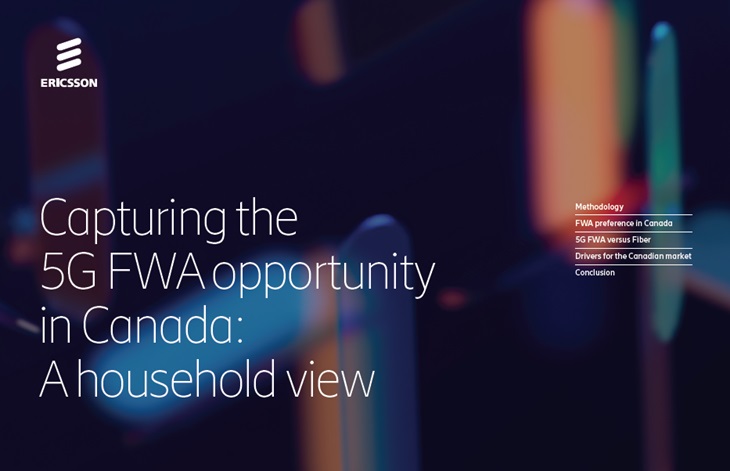
While awareness of fixed wireless access (FWA) as a home connectivity option is currently low in Canada, households are primed to make 5G FWA their preferred type of broadband connectivity, according to a new Ericsson ConsumerLab report.
Titled Capturing the 5G FWA opportunity in Canada: A household view, the report is based on a survey of 1,000 household representatives across Canada and interviews with 200 active FWA users, conducted from August to October 2023.
According to the report, 70 per cent of Canadian households are not even aware of FWA as a technology. In addition, one in three households who do know about FWA are not aware of any provider offering FWA, the report says.
The study found 74 per cent of Canadian households believe they have fixed broadband today and nearly 67 per cent of households are satisfied with their current home connectivity.
However, mobile connectivity has earned a significant share of overall broadband connectivity, with 37 per cent of Canadian households reporting wireless (via FWA, smartphone, mobile hotspot or something similar) as their most used connectivity. In comparison, 47 per cent of U.S. households and 39 per cent of households globally reported wireless as their most used connectivity.
“With slightly more than a third of the market expressing comfort with wireless, cellular service providers may need to expand efforts to make consumers aware of FWA in order to facilitate entry into the market and faster adoption of 5G FWA in Canada,” the report says.
Despite the low awareness about FWA, Ericsson has noted a shift in trend with 5G FWA growing as the leading broadband choice for Canadian households.
“More than half of Canadian households chose 5G FWA as their primary connectivity (as opposed to being a complement) last year, an amount that has been steadily rising over the last two years,” the report says.
“Among those adopting 5G FWA, loyalty is strong. Fewer than one in twenty households using 5G FWA would consider terminating their subscription within a year,” the report adds.
According to the report, Canadian households believe 5G FWA achieves fibre-level performance while delivering a more satisfying service experience than fibre. They expressed stronger customer loyalty for 5G FWA — more than 12 per cent higher — than for fibre, and they rated 5G FWA significantly above fibre when it comes to cost and most other criteria except technical support. Canadian users rated technical support for 5G FWA 11 per cent worse than for fibre, the report says.
When it comes to network quality, however, some improvement is needed. 5G FWA fell very slightly below fibre in six main network-related selection criteria (security, indoor coverage, capacity, speed, reliability and latency), the report says, noting 5G FWA still had the confidence level to be on par with fibre.
In terms of differentiation, price stands out as the most significant differentiation criteria. As noted above, network satisfaction levels among Canadian 5G FWA users are almost on par with fibre users. In addition, 5G FWA clearly outperforms coaxial cable in terms of user recommendation scores, according to the report.
“5G FWA rises above the other offerings in the area of price and customer loyalty for Canadian users,” the report says.
In addition to price and promotions, other highly ranked reasons for choosing FWA include bundling possibilities with other services, convenience-based attributes such as ease of installation, and availability particularly in smaller cities and towns where fibre is not a connectivity option. In metropolitan areas and large cities, drivers to adopt FWA include access to the latest technology and better speed, the report says.
The report makes a number of general recommendations for how service providers can increase FWA adoption in Canada, such as promoting speed-tiered-based FWA offerings to emphasize the speed and reliability of the service, using localized ads for targeted areas, creating trial promotions so consumers can “try and buy” FWA, and developing tailored positioning for FWA based on the competitive situation and broadband adoption in the market.
Some of the tailored FWA offerings suggested by Ericsson ConsumerLab include: low-price FWA offerings featuring low speeds and self-installed indoor equipment, promoted with bundled offers, for value-conscious customers; high-speed plans (300-500 Mbps) using outdoor receivers, customer premise equipment or self-install flexible installation receivers, leveraging 5G standalone technology with network slicing for superior performance and reliability; and customized offerings featuring fast and reliable FWA plans (typically 100 Mbps), providing add-on paid services for entertainment, such as streaming and gaming, as well as security features and customer service, including a loyalty program, installation support and IT services.
Screenshot of the front cover of Ericsson ConsumerLab’s Capturing the 5G FWA opportunity in Canada: A household view report.



